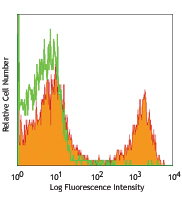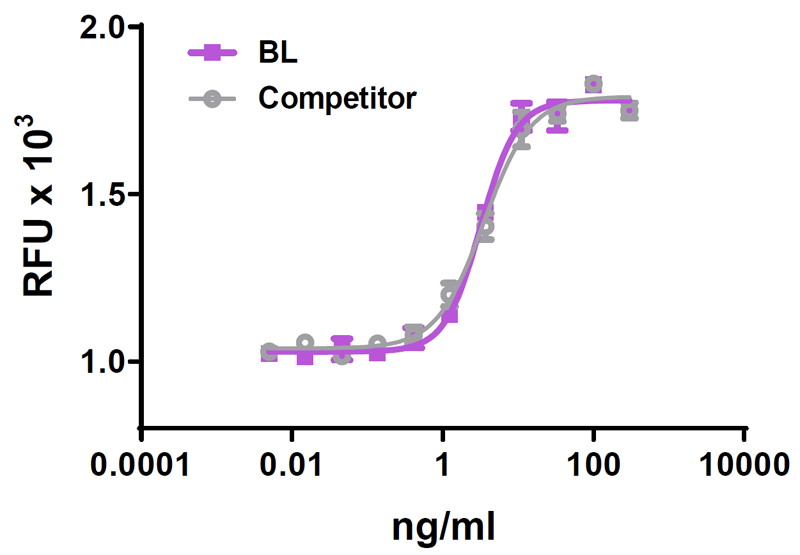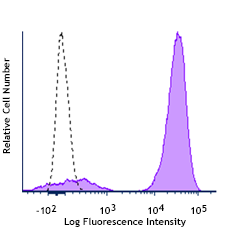- Regulatory Status
- RUO
- Other Names
- MHC tetramer, HLA tetramer, HLA monomer, MHC monomer, biotinylated HLA monomer
- Ave. Rating
- Submit a Review
- Product Citations
- publications

-

Flex-T™ HLA-A*11:01 monomer UVX was subjected to UV-activated peptide exchange with an EBV peptide (IVTDFSVIK). The resulting new monomer was assembled into tetramers with PE- or APC-conjugated streptavidin. Human PBMCs from an HLA-A11 positive donor were stained with both PE- and APC-labeled tetramers. Data shown were cells gated on live CD8+ (CD4, CD19, CD14, CD16)- lymphocytes. -

The bar graph shows ELISA results after peptide exchange on Flex-T™ HLA-A*11:01 monomer UVX. The UVX monomer was irradiated with UV light in the presence of a positive (Pos) or negative (Neg) peptide, or no peptide (UV only). The positive peptide is an HLA-A11 epitope from EBV (IVTDFSVIK); the negative peptide is an HLA-B7 epitope from RSV (NPKASLLSL).
| Cat # | Size | Price | Quantity Check Availability | Save | ||
|---|---|---|---|---|---|---|
| 280007 | 50 µg | £715 | ||||
CD8+ T cells are essential components of the immune system. They function through TCR recognition of antigens (peptide epitopes) presented by the class I MHC (HLA in humans) molecules. Thus, TCR recognition of cognate MHC/peptide complex can be utilized for the detection of antigen-specific CD8+ T cells. Due to the intrinsic low affinity of MHC/TCR interaction, the detection of antigen specific T cells requires enhanced binding avidity by multimerization of MHC/peptide monomers, ensuring the interaction of multiple MHC/TCR simultaneously. This can be accomplished by using streptavidin to tetramerize biotinylated MHC class I complexes.
In the absence of proper peptide binding, the HLA class I complex will quickly disassociate. Flex-T™ UVX (Ultraviolet Exchange) monomer is designed as a biotinylated α-chain, associated with the β2-microglobulin chain, and stabilized by a UV-labile peptide. The C-terminus of the α-chain is site-specifically biotinylated by the enzyme BirA. When the complex (monomer) is irradiated with UV in the presence of a new peptide with proper affinity, it will result in a net peptide exchange. The new peptide replaces the pre-loaded UV-labile peptide and forms a new MHC monomer. The new monomers can be then tetramerized and used for labeling antigen-specific T cells or other studies.
Product Details
- Verified Reactivity
- Human
- Formulation
- PBS (pH 7.5) containing 0.5% BSA and protease inhibitors.
- Concentration
- 0.2 mg/ml
- Storage & Handling
- Store frozen (-20 or -80°C); shipped in blue ice. Aliquot upon receipt before freezing; avoid repeated freeze-thaw cycles. Protect from light.
- Application
-
ELISA - Quality tested
FC - Verified - Recommended Usage
-
For flow cytometric staining, the suggested use of this reagent is 20μl of 0.2mg/ml biotinylated monomer, mixed with 20μl of 400μM peptide, following our recommended protocol. This will generate tetramers sufficient for 15 tests (single color staining) or 7 tests (two-color staining).
- Application Notes
-
Flex-T™ HLA-A*11:01 Monomer UVX offers the flexibility of exchanging the pre-loaded UV-sensitive peptide to other antigenic peptides of interest before assembling tetramers for flow cytometry analysis. This product can also be used for the screening of peptide epitopes that are able to form a stable complex with the HLA-A*11:01 allele.
Two-color staining with the same allele/peptide combination is recommended for flow cytometry analysis to increase the resolution and specificity of the assay.
If peptides already characterized and published are preferred, click here to view.
To order custom products please fill out the Custom Flex-T™ Request Form. -
Application References
(PubMed link indicates BioLegend citation) -
- Altman JD, et al. 1996. Science 274:94-6.
- Rodenko B, et al. 2006. Nat. Protoc. 1:1120.
- Toebes M, et al. 2006. Nat. Med. 12:246.
- Bakker AH, et al. 2008. Proc. Natl. Acad. Sci. USA 105:3825.
Antigen Details
- Biology Area
- Immunology
- Molecular Family
- MHC Antigens
- Gene ID
- NA
Related Pages & Pathways
Pages
Related FAQs
- Is there any peptide length recommended?
-
There are no special requirements for the peptides. Peptides that naturally bind to MHC molecules will bind to Flex-T™ reagents. For class I molecules, typical length is about 8 – 10 amino acids. Class II molecules accommodate longer peptides, about 14 – 20 amino acids1.
1) Mohan JF and Unanue ER. Unconventional recognition of peptides by T cells and the implications for autoimmunity. Nat Rev Immunol. 2012 Oct;12(10):721-8. - What are MHC tetramers and what can you do with them?
-
The T-cell mediated innate immune response is defined by the interaction between antigen presenting cells and T cells, through the Major Histocompatibility Complex (MHC) and the T cell receptor (TCR). MHC molecules present a peptide to antigen-specific T cells that recognize this peptide. Soluble, monomeric MHC molecules bind very weakly to the TCR. However, by making a tetramer through a fluorescently labeled streptavidin conjugate, the complex binds to several TCRs, creating a more stable interaction and making it useful for flow cytometric detection of antigen specific T cells.
- I am interested in finding novel peptides instead, are there any resources for this?
-
There are a number of databases and webpages that can help, these are three of them:
- What are the specifications of the UV source?
-
Long-wave UV, 366 nm, 8 Watts (We recommend, for example, CAMAG cat# 022.9115, or Ultraviolet Crosslinker CL-1000). The distance from the solution to the light source should be 2 – 5 cm (approximately 0.8 – 3 inches).
- What is Flex-T™?
-
Flex-T™ (Flexible-Tetramers) is BioLegend’s brand name for our Soluble MHC product line. It encompasses monomers, the ultraviolet (UV) peptide exchange technology, and all associated products and applications.
- Do I need to know the sequence of the UV-labile peptide?
-
The sequence of the UV-labile peptide is not needed to use the reagent. MHC molecules are not stable without a peptide, so these peptides are used just for two purposes: stabilize the MHC molecules and serve as a place holder to be substituted by the peptide of interest.
- Do you offer mouse monomers or tetramers?
-
We offer a selection of fixed peptide mouse monomers within our catalog. We also produce mouse monomers and tetramers as Custom Flex-T™ Reagents.
- Do you offer custom products and services?
-
Yes, please contact our Custom Solution Team with your request at cst@biolegend.com, or contact your local BioLegend representative.
- How do I evaluate the efficiency of the peptide exchange?
-
Follow the protocol for HLA class I ELISA. An assay positive control is provided (Cat#280301) that can be diluted to a high, medium, and low concentration. Signal intensity can be correlated to affinity of the peptide.
- What is the peptide exchange technology and what's the advantage of using it?
-
Flex-T™ MHC monomers are loaded with a peptide that can be degraded by the use of a UV light source. This allows for a peptide exchange when the UV irradiation is done in the presence of the peptide of interest (which is not UV-labile). This flexibility permits the screening of virtually any peptide of interest with enough affinity for the MHC allele that it is loaded onto.
- Is it feasible to screen not just peptides, but also several specificities of antigen-specific T cells in one sample?
-
With the traditional pre-assembled Tetramer approach, this is difficult to do, and not cost-effective. With Flex-T™ technology, as there is more flexibility to assemble the tetramers, it is easy and affordable to screen a sample for several specificities2. To facilitate this approach, a combinatorial color coding system has been developed. Please visit the Flex-T™ webpage for a detailed description.
2) Hadrup SR et al. Parallel detection of antigen-specific T-cell responses by multidimensional encoding of MHC multimers. Nat Methods. 2009 Jul;6(7):520-6. - Is there any advantage in buying biotinylated monomers?
-
Yes, the same monomer can be assembled with different Streptavidin conjugates, providing great flexibility for color choices. Additionally, it can be stored frozen and the tetramer assembled shortly before the experiment. This increases the storage time of the reagent.
 Login / Register
Login / Register 


















Follow Us